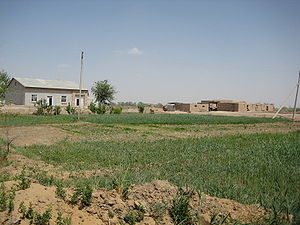- Dehkan farm
-
A dehkan farm (Uzbek: деҳқон хўжаликлари, Tajik: хоҷагиҳои деҳқонӣ (фермерӣ), Turkmen: daýhan hojalyk, Russian: дехканские хозяйства) is a term for an individual or family farm in Central Asia. Originally a Persian word used by the Sassanid Empire, it is still utilized in the classification systems of several regional governments.
Contents
Uzbekistan
In Uzbekistan, household plots were reclassified as "dehkan farms" in 1998, at which time the Law of Dehkan Farms was passed.[1] Around 60% of all agricultural production in the country comes from dehkan farms,[2] which control less than 5% of arable land in the country and average less than 0.2 hectares in size.[3]
The small dehkan farms grow vegetables and raise livestock. Scale crops, such as wheat and cotton, are usually grown on larger peasant farms (average size more than 40 hectares[3]) and on the few remaining shirkats (former collective farms). All agricultural land in Uzbekistan is owned by the state. While this situation allows the state to demand certain performance and production standards from larger farms, dehkan farms are allowed to grow whatever the farmers wish. Additionally, unlike larger farms where leases must be renewed, leases for dehkan farms are lifetime holdings and can be transferred through inheritance. They cannot, however, be sold or given to someone outside the family as a gift.[4]
Dehkan farms own 93% of all cattle in Uzbekistan.[5]
Tajikistan
In Tajikistan, "dehkan farms" are midsized peasant farms that are legally and physically distinct from household plots. Regulations concerning dehkan farms in Tajikistan are laid out in the Law No. 48 on Dehkan Farms, dating from 2002.[6]
Dehkan farms cultivate more than 60% of agricultural land in Tajikistan,[7] averaging about 20 hectares in size (compared to less than 2 hectares in household plots).[8] Dehkan farms concentrate in crop production (cotton, wheat, and vegetables) and their share of livestock is minimal.[9]
See also
Notes
- ^ Lerman 2008, 482.
- ^ Lerman 2008, 492.
- ^ a b Lerman 2008, 488, 495.
- ^ Lerman 2008, 484-486.
- ^ "Dekhkan possess 93% of cattle in Uzbekistan". Uzbekistan Daily. May 15, 2009. http://www.uzdaily.com/articles-id-5734.htm.
- ^ Tajikistan: Law No. 48 on Dehkan Farms Food and Agricultural Organization of the United Nations
- ^ Lerman and Sedik 2009, 308.
- ^ Lerman and Sedik 2009, 320.
- ^ Lerman and Sedik 2009, 310.
References
- Lerman, Zvi (2008). "Agricultural Development in Central Asia: A Survey of Uzbekistan, 2007–2008". Eurasian Geography and Economics 49 (4): 481–505. doi:10.2747/1539-7216.49.4.481. http://bellwether.metapress.com/content/x06m0123v5635358/?p=bdc729471c494bd8911049fec55f5f35&pi=5.
- Lerman, Zvi; Sedik, David (2009). "Agricultural Development and Household Incomes in Central Asia: A Survey of Tajikistan, 2003-2008". Eurasian Geography and Economics 50 (3): 301–326. doi:10.2747/1539-7216.50.3.301. http://bellwether.metapress.com/content/k41353h358144883/?p=92df6fbf7ce746388f173d2c2cb44481&pi=3.
Categories:- Agriculture stubs
- Uzbekistan stubs
- Tajikistan stubs
- Agriculture in Uzbekistan
- Agriculture in Tajikistan
Wikimedia Foundation. 2010.

